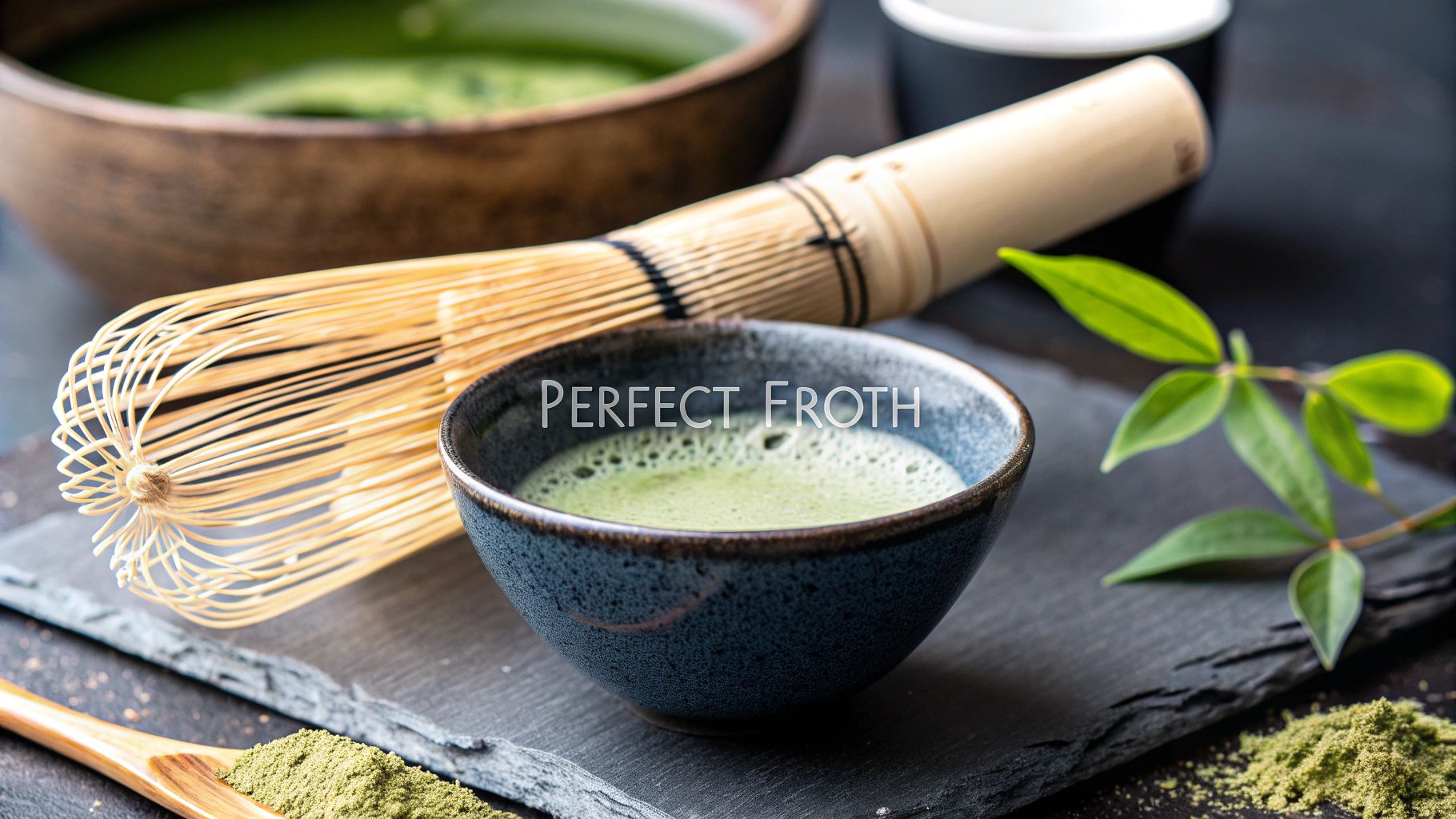If you want to master making matcha, the first thing you need to get your head around is why the whisk is so important. A proper bamboo whisk, called a chasen in Japan, is specifically designed to suspend the fine matcha powder perfectly in water. This is what creates that iconic, smooth frothy layer that an electric frother just can't touch, and it's the absolute key to unlocking the tea's true flavour.
Why a Bamboo Whisk Is Your Secret to Better Matcha
Before we even get to the whisking technique, let's talk about the tool itself. We know what you’re thinking: "Can't I just use my electric milk frother or a little metal whisk?" And while you can use them to mix the powder, they simply don't create the delicate microfoam that defines an authentic, café-quality bowl of matcha.
Think of a bamboo chasen less as a mixer and more as an aerator. Its 100 fine, flexible tines are masterfully crafted to whip air into the tea, creating a velvety, creamy consistency. This rich layer of foam, known as usucha, is what mellows out any potential bitterness and brings forward the deep, umami notes you find in high-quality blends like Amatsu Matcha’s Pure and Radiance.
The Art and Science of the Chasen
Using a chasen turns making tea from a simple task into a rewarding ritual. The controlled, intentional movement connects you to the whole process, making each bowl a moment of mindfulness. It’s a world away from the harsh whirring of an electric gadget, which tends to create big, soapy bubbles instead of that gorgeous, delicate foam we’re after.
The craftsmanship behind each chasen is a tradition that's been refined over centuries. This heritage is so important that the matcha whisk holds deep cultural significance, not just in its Japanese origins but also in the UK’s growing tea culture. The artisan craft has been around for over 500 years, with only a handful of masters keeping the skill alive. It really makes the whisk a symbol of dedication and quality. You can dive deeper into the history and importance of the matcha whisk in our detailed guide.
The goal isn't just to mix the matcha—it's to awaken it. The chasen's unique design gently suspends the fine powder and aerates the liquid, a process that fully releases its complex flavour profile and creamy texture.
Why Other Tools Fall Short
Look, modern gadgets are great for many things, but they just can't compete with a chasen for making matcha. Here's why:
- Uneven Mixing: A standard metal whisk has thick tines that can’t get into the nooks and crannies of the bowl to properly suspend the fine matcha particles. You'll almost always end up with clumps.
- The Wrong Kind of Froth: Electric frothers are far too aggressive. They create large, unstable bubbles that disappear in seconds, failing to produce the lasting, creamy head that a properly whisked matcha should have.
- Damaged Flavour: The intense friction from a blender or powerful frother can actually heat the matcha, introducing a burnt, bitter taste that completely masks its natural sweetness and potent benefits.
Honestly, investing in a proper bamboo whisk is the single most important step you can take to elevate your matcha game at home. It makes all the difference.
How to Choose the Right Chasen for Your Needs
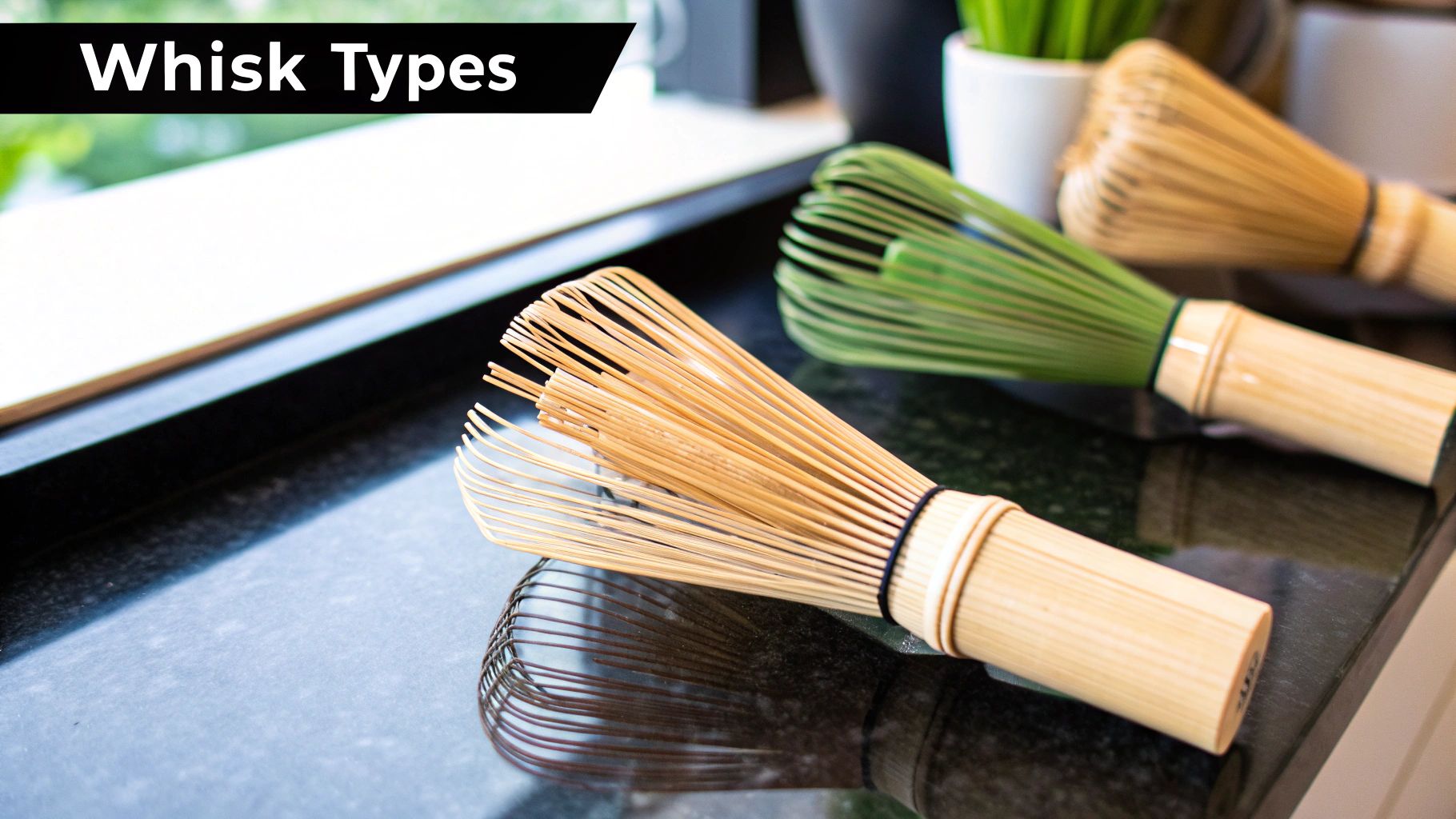
Walking into the world of matcha tools can feel a little overwhelming at first, especially when faced with rows of seemingly identical bamboo whisks. But here's the secret: the most important difference between one chasen and another comes down to the number of prongs, or tines.
This single factor—the tine count—is what will shape the final texture and froth of your matcha. More tines mean a finer, more delicate foam. Think of it as the difference between a thick paintbrush and a fine-tipped pen. One is for broad, quick work, while the other is for creating something truly delicate and refined.
Understanding Tine Counts
You'll most commonly come across chasens with 80, 100, or 120 tines. While they all serve the same fundamental purpose, each is crafted for a slightly different style of matcha preparation. Choosing the right one is your first real step toward mastering the perfect bowl.
-
The 80-Tine Whisk: This is the robust workhorse of the matcha world. It's built for making koicha, which is a much thicker, almost paste-like preparation of matcha. Its stronger, less flexible prongs are perfect for blending a large amount of powder into a small amount of water to get that smooth, rich consistency without creating too much froth.
-
The 100-Tine Whisk: If you're looking for the ideal all-rounder, this is it. The 100-prong chasen is what most people imagine when they think of a matcha whisk. It strikes a fantastic balance, easily whipping up a lovely, consistent froth for your daily bowl of usucha (thin tea). It’s the perfect partner for versatile, functional blends like Amatsu's Strength (with ashwagandha) or our energising Shrooms blend.
-
The 120-Tine Whisk: Consider this the artist's brush. This chasen is designed for the fine art of ceremonial preparation. With so many fine, flexible tines, it makes whipping up a velvety, dense microfoam feel almost effortless. It’s the best choice for showcasing the delicate notes of a high-grade blend like Amatsu's Pure or our skin-loving Radiance collagen matcha.
Your choice of whisk really does set the stage for your entire matcha experience. For daily drinkers, a 100-tine chasen is a brilliant and versatile starting point. If you’re chasing that ultimate creamy foam, the 120-tine elevates the ritual.
A Quick Comparison to Help You Choose
To make it even clearer, here's a simple breakdown of how the different tine counts stack up against each other.
Matcha Whisk Tine Count Comparison
| Tine Count | Best For | Foam Quality | Recommended Matcha |
|---|---|---|---|
| 80 | Thick matcha (koicha) | Low foam, smooth, paste-like consistency | Rich, ceremonial-grade koicha blends |
| 100 | Daily thin matcha (usucha) | Good, consistent foam; balanced texture | Everyday blends like Amatsu's Strength or Shrooms |
| 120 | Ceremonial thin matcha (usucha) | Rich, velvety microfoam with minimal effort | Delicate, premium blends like Amatsu's Pure or Radiance |
Ultimately, the right whisk for you depends on how you enjoy your matcha. Don't be afraid to start with a versatile 100-tine and explore from there.
Beyond the Prongs, Quality Matters
While the number of tines is your primary guide, the overall craftsmanship of the chasen is just as crucial. A well-made whisk isn't just a tool; it's a piece of functional art.
Look for a chasen carved from a single piece of bamboo—this is the hallmark of traditional quality. The tines should be finely split and evenly spaced, with a gentle curl at the tips. The central knot holding it all together should be tight and secure.
Investing in a quality whisk from the get-go makes a huge difference. Not only will it perform better, creating a smoother, more flavourful bowl every time, but it will also last significantly longer with the right care. This one choice can elevate your daily matcha ritual for years to come.
Mastering the Whisking Motion for Perfect Foam
Right, you’ve picked out your chasen. Now for the fun part. This is where we turn that fine green powder from a potentially clumpy, underwhelming drink into something truly special: a vibrant, smooth, and flavourful bowl of matcha. It all hinges on getting the whisking motion just right.
Before a single grain of matcha touches the water, you need to prep your whisk. It's a simple but vital step often called ‘blooming’ the chasen. Just let the tines soak in a bowl of warm water for a minute or two. This small act makes the delicate bamboo soft and pliable, which not only prevents them from snapping but also helps them whip up the finest foam imaginable.
The Signature 'W' Motion
Once your chasen is nicely softened, it’s time to get whisking. Forget the slow, circular stirring you’d use for a cup of coffee. The classic matcha technique is all about a rapid, energetic movement that comes straight from the wrist. You’re essentially tracing a quick ‘W’ or ‘M’ pattern back and forth across the bottom of the bowl.
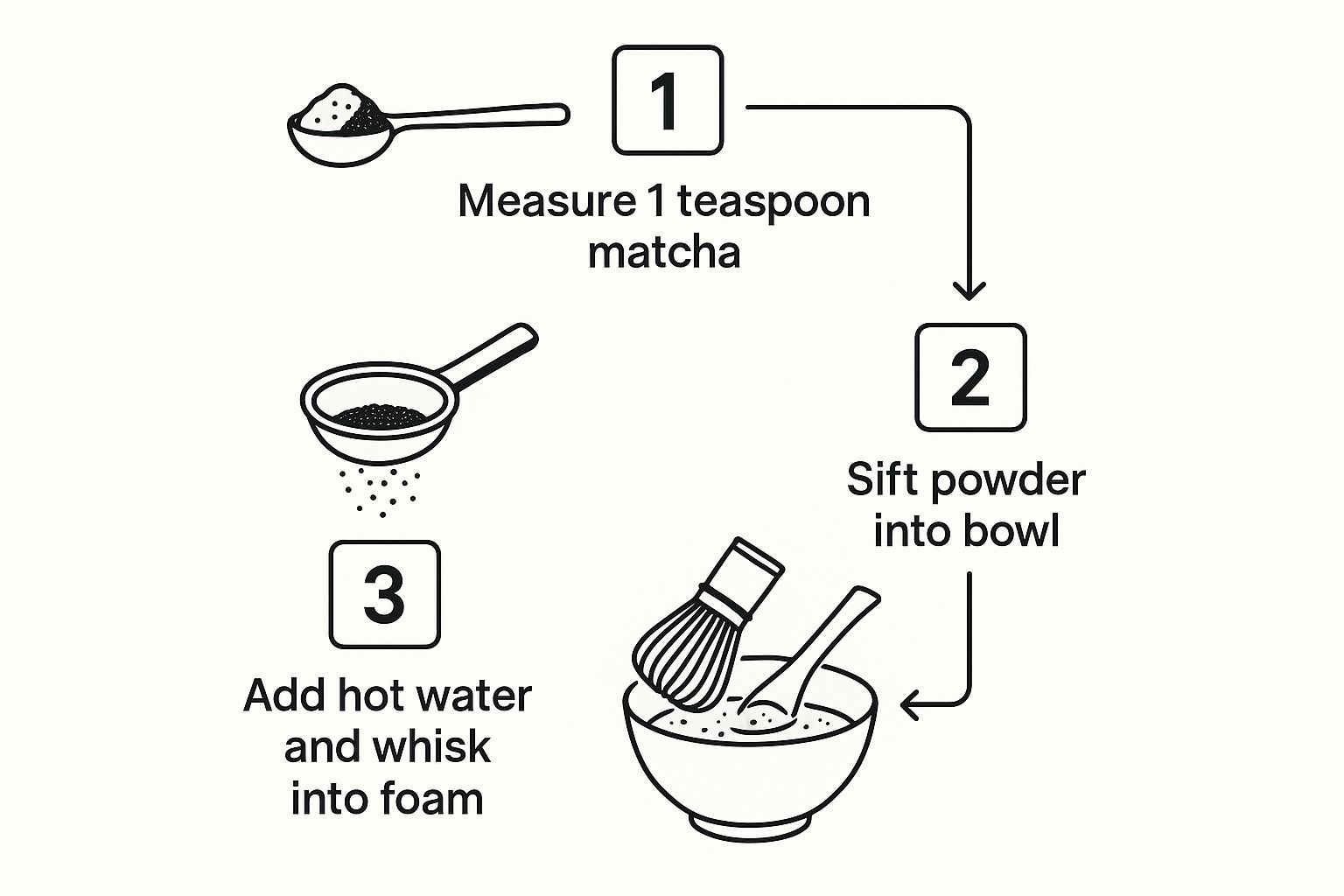
Think of it like you're trying to write the letter 'W' over and over again, as fast as you can. Your wrist needs to be loose and relaxed—let the whisk do the heavy lifting. It’s this specific zig-zag motion that brilliantly aerates the tea, creating that rich, velvety microfoam that is the hallmark of a perfect bowl of matcha.
As the image above shows, sifting the powder before you add water is absolutely non-negotiable if you want a silky, clump-free texture.
This technique is key to unlocking the full potential of your matcha, no matter the grade. Without it, you’re simply not getting the intended texture or flavour. I’ve seen so many newcomers get frustrated with lumpy matcha until they nail this motion. In fact, UK tea educators have noted that around 45% of new matcha drinkers in the UK initially struggle with clumping until they’re shown the proper whisking technique.
Insider Tips for Flawless Foam
Perfecting your technique takes a bit of practice, but a few pointers from experience can definitely speed up the learning curve. Here are a few things to keep in mind:
- It’s All in the Wrist: Seriously. The power comes from a quick flick of the wrist, not your whole arm. A stiff arm just scratches the bowl and won't create much foam.
- Keep a Light Touch: Don't press the whisk hard against the bottom of the bowl. The idea is to agitate the surface of the liquid, whipping air into it, not grinding the powder into the ceramic.
- Time It Right: You don't need to go on forever. A vigorous whisk for about 15-20 seconds is usually all it takes to build a beautiful, stable layer of foam.
- The Final Flourish: To pop any larger bubbles and create a smoother surface, gently lift the whisk to the surface and draw a slow circle, or the Japanese character for ‘no’ (の), before you pull it out.
Stick with these guidelines, and you'll be creating consistently flawless, frothy matcha in no time. For a more in-depth look, you can also check out our guide on how to whisk matcha to really refine your skills.
Common Whisking Mistakes and How to Fix Them
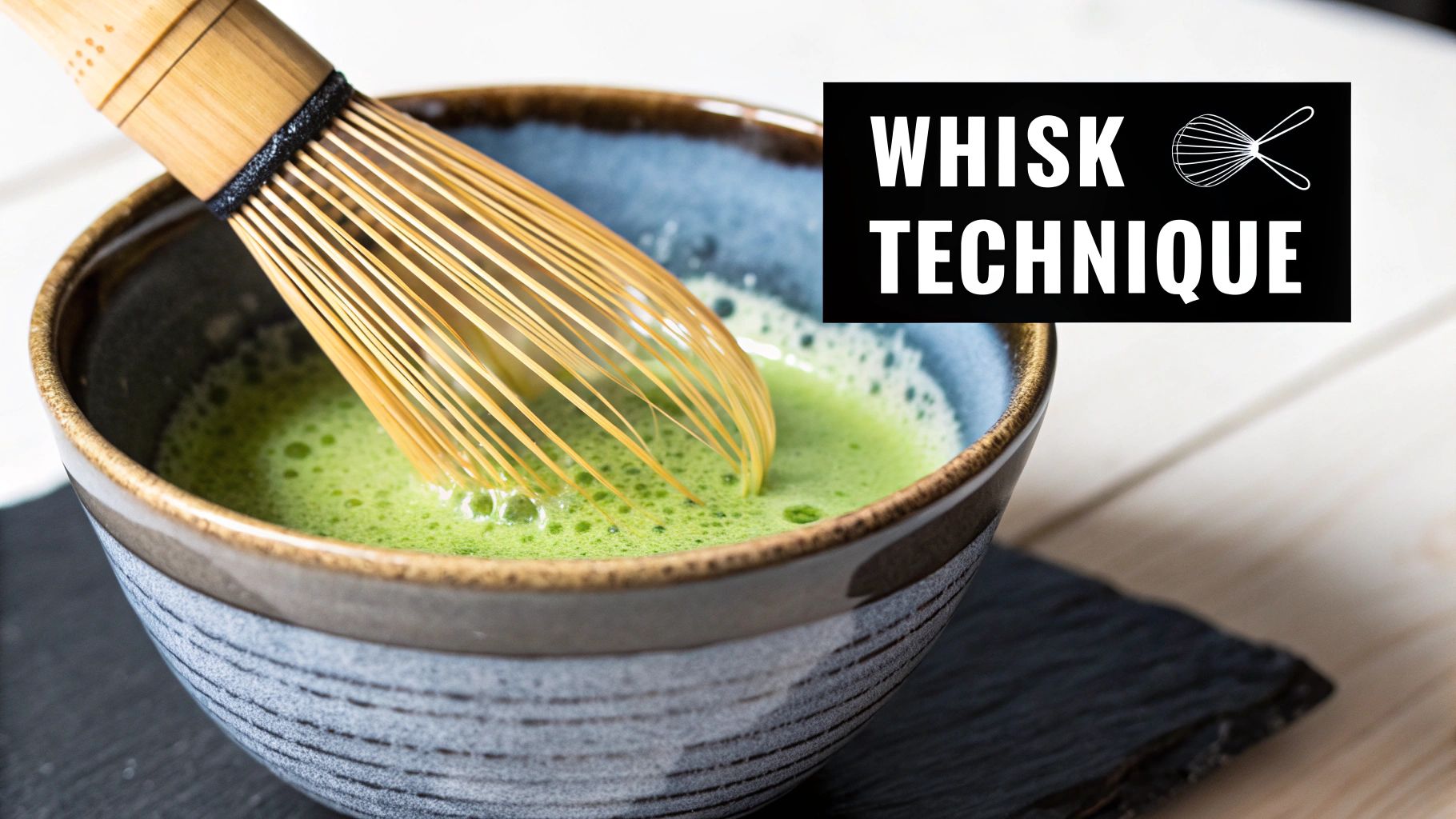
Even with a top-notch chasen and the best matcha powder, things can sometimes go sideways. If your matcha isn't turning out quite right, don't get discouraged—it's a common experience. Most issues boil down to a few small, easily correctable habits.
Think of this as your personal troubleshooting guide. Once you pinpoint the problem and apply the right fix, you’ll be on your way to a flawless bowl every single time. It's often the little tweaks that make the biggest impact.
The Problem of Large Soapy Bubbles
Ever whisked your heart out only to end up with big, soapy-looking bubbles instead of that dreamy, creamy microfoam? This is one of the most frequent frustrations for newcomers, and the culprit is almost always the same: your water is too hot.
Pouring boiling water over delicate matcha leaves essentially scorches them. This not only creates a harsh, bitter flavour but also ruins your chances of building a stable, velvety foam. The sweet spot for matcha is water around 80°C (175°F). If you don't have a temperature-controlled kettle, no problem. Just let your boiled water cool down for a minute or two before you pour.
Why Your Matcha Is Clumpy
Nothing spoils the smooth, silky texture of a good matcha like finding little green clumps at the bottom of your bowl. These clumps appear when the powder hasn't fully suspended in the water, a problem that even the most energetic whisking can't always fix on its own.
The solution is wonderfully simple: sift your matcha powder. Using a small, fine-mesh sieve to sift the powder directly into your bowl is a total game-changer. This small step breaks up any clumps caused by static and aerates the powder, helping it dissolve beautifully for a perfectly smooth consistency.
A quick sift takes less than 30 seconds but makes the difference between a gritty drink and a perfectly smooth, café-quality bowl. It is the single most effective step for preventing clumps.
The Dreaded Scratching Sound
If you hear the tines of your chasen scraping against the bottom of your bowl, it’s a sure sign you’re pushing down too hard. This is a common mistake when you're trying to whisk with energy, but it's actually counterproductive and can damage both your whisk and your bowl over time.
Remember, the goal is to whip air into the liquid, not grind the powder into the ceramic. Keep a light grip and focus your rapid 'W' or 'M' motion on the surface of the tea, letting just the tips of the tines do all the work. Your wrist should be loose and relaxed, which allows for speed without brute force.
For a complete walkthrough, check out our guide on how to prepare matcha. A lighter touch will not only create a much better foam but will also significantly extend the life of your bamboo whisk.
How to Care for Your Bamboo Whisk
https://www.youtube.com/embed/VmA6SUFDBFg
Your bamboo whisk, or chasen, is a delicate, natural tool. It needs a little bit of care to keep it in good shape, but with a few simple habits, you can make it last for years. Think of it as protecting your investment in a quality ritual.
The golden rule of chasen care is this: never use soap or put it in the dishwasher. Harsh detergents strip the bamboo’s natural oils, making the delicate tines brittle and likely to snap. Even worse, the bamboo can absorb a soapy taste, which will ruin every future bowl of matcha you make.
The Proper Cleaning Routine
Cleaning your whisk is quick and easy. As soon as you've finished making your matcha, just rinse the tines thoroughly under a gentle stream of warm water.
Another great way to clean it is to fill your matcha bowl (chawan) with fresh warm water and whisk for a few seconds. This will dislodge any lingering powder. Gently run your fingers over the tines to make sure all the green residue is gone, then give it a little shake to get rid of excess water. That's it.
Why Air Drying Is Essential
How you dry your chasen is just as important as how you clean it. Tossing a wet whisk back into its plastic container or laying it on its side is a recipe for disaster. Moisture gets trapped, which can lead to mould and cause the tines to lose their elegant curl, eventually unravelling the central knot.
This is where a whisk holder, known as a kusenaoshi, comes in. It’s a non-negotiable part of the kit for me. When you place your damp whisk on a holder, air can circulate freely around every single tine. This does two critical things:
- It prevents mould: Airflow ensures the bamboo dries completely, stopping mould in its tracks.
- It maintains the shape: The holder helps the outer tines keep their curl and encourages the inner tines to open up, preserving the whisk’s all-important structure.
Using a kusenaoshi is the single most effective thing you can do to prolong the life and preserve the shape of your chasen. It’s not just an accessory; it’s an essential tool for proper matcha care.
British consumers are increasingly drawn to matcha, not just for its wellness advantages but for the authentic, hands-on experience of preparing it. Online retailers in the UK have seen steady growth in sales of traditional tools like the chasen, which really shows a shift toward authenticity and mindful rituals.
Proper care ensures your tools remain pristine, connecting you to this beautiful tradition while safeguarding the remarkable matcha powder health benefits you seek in every bowl.
Your Matcha Whisk Questions Answered

Even after walking through all the steps, a few questions inevitably pop up. I’ve put this section together to tackle some of the most common queries I hear from people just starting their matcha journey. Think of it as a final troubleshooting guide to clear up any lingering doubts.
We'll cover everything from whether you can cheat with a milk frother to knowing when your beloved chasen has finally given its all. Let's build your confidence one answer at a time.
Can I Use a Milk Frother Instead of a Chasen?
This is the big one, and the honest answer is: yes, you can, but you'll be missing out on what makes matcha truly special.
An electric milk frother is a powerhouse for creating foam, but it produces big, airy bubbles, much like you’d find on a cappuccino. The magic of a traditional bamboo chasen lies in its ability to whip up a delicate, dense microfoam. It’s this creamy, velvety layer that mellows the matcha's flavour profile and creates that signature smooth mouthfeel.
So while a frother will get the job done and mix your powder, it just can't replicate the authentic texture and full-bodied taste you get from proper whisking. For that truly exceptional cup, the chasen is still king.
How Do I Break In a New Matcha Whisk?
Breaking in a new chasen is a small but crucial first step. The idea is to gently soften the bamboo tines and unfurl that central knot, getting it ready for action. It’s wonderfully simple.
Before you make your first bowl, just let the new whisk soak in warm (not boiling!) water for about five minutes. You’ll see the tightly coiled tines in the centre start to relax and open up. This initial soak makes the bamboo more pliable, which is key to preventing the delicate tips from snapping when you start whisking.
A brand-new whisk has stiff, tightly coiled tines. A quick soak in warm water is all it takes to 'bloom' the bamboo, making it flexible enough to create that beautiful foam without risking any damage.
Why Isn't My Matcha Frothing Properly?
Struggling to get a good froth? It’s a common frustration, but usually, it comes down to one of three things. Let’s run through the likely culprits.
- Water Temperature: This is a big one. Water that’s too cool won't dissolve the matcha properly, and boiling water will scorch it, leaving a bitter taste and large, unstable bubbles. Your sweet spot is around 80°C (175°F).
- The Matcha-to-Water Ratio: If your brew is too watery, you'll never get a good foam. Try using a little less water or a slightly more generous scoop of matcha until you find the balance that gives you a creamy consistency to work with.
- Your Whisking Technique: Remember, this isn’t a gentle stir. You need a rapid "W" or "M" motion, driven by your wrist. It's those quick, energetic flicks that pull air into the mixture and build the foam.
Sometimes, it can also come down to the matcha itself. Lower-grade powders are often trickier to froth than high-quality ceremonial grades like Amatsu Matcha's Pure or Radiance blends. A premium, finely stone-milled powder is just so much more receptive to aeration. Plus, exploring the incredible matcha health benefits is another great reason to opt for quality.
When Should I Replace My Bamboo Whisk?
Even a well-cared-for chasen isn't immortal. Over time, the delicate bamboo tines will naturally wear down from all that whisking. It’s time for a new one when you spot a few tell-tale signs.
Take a close look at the tines. Have they lost their curl and gone straight? Are the tips starting to break off? Once you’ve lost more than a couple of tips, the whisk’s ability to create a decent froth is seriously compromised. A thinning whisk simply can't aerate the tea the way it needs to.
With proper cleaning and drying on a kusenaoshi (a whisk holder), a quality chasen should easily last you many months, and often up to a year, even with daily use.
Ready to perfect your ritual with a blend crafted for exceptional flavour and froth? Explore the Amatsu Matcha collection and discover the difference that premium, ceremonial-grade matcha can make in your daily wellness practice. Start your journey at https://amatsumatcha.com.
Read more

Searching for where to buy matcha tea powder? Our UK guide reveals the best online stores and shops for finding high-quality ceremonial and culinary matcha.
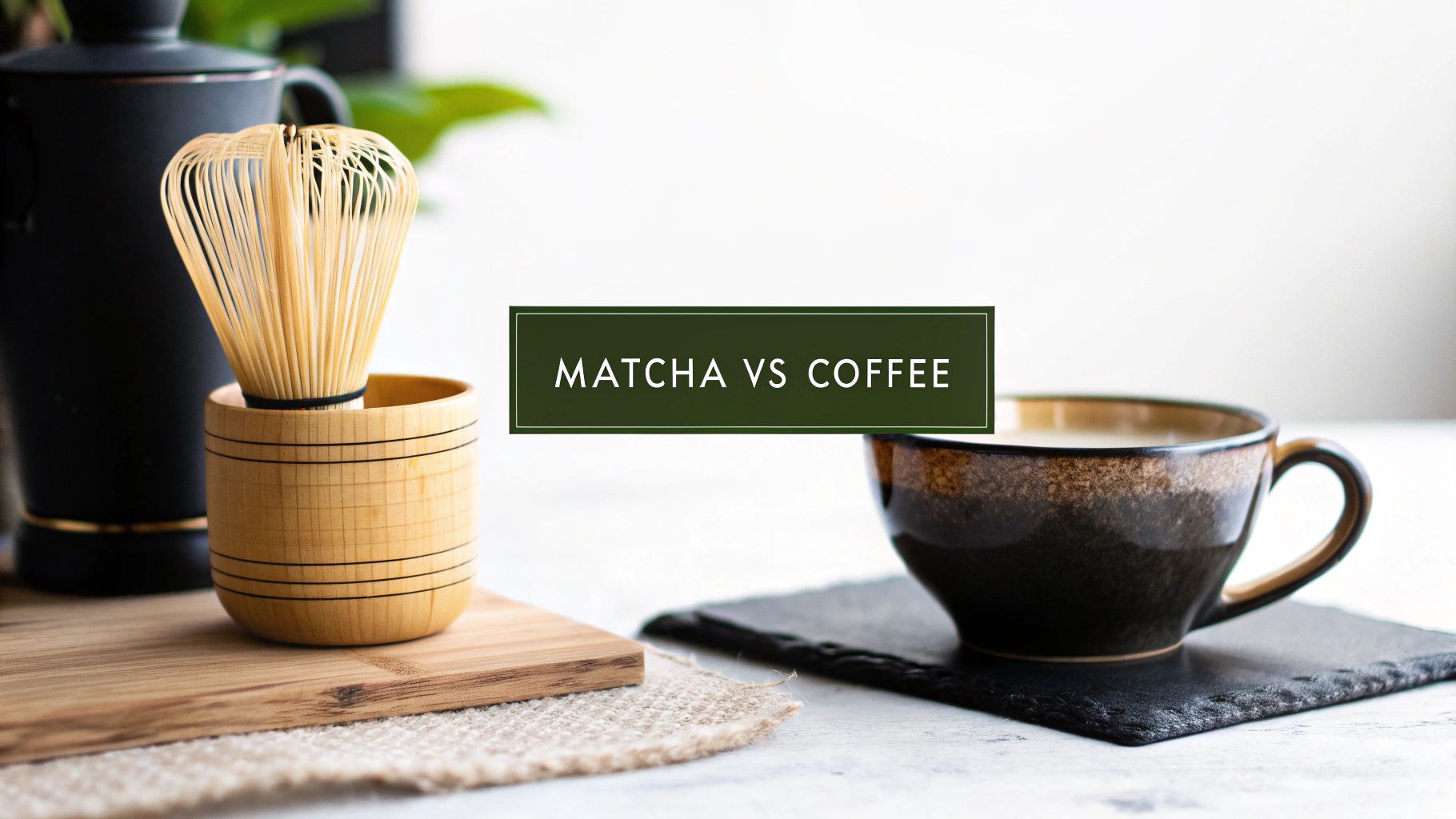
Is matcha better than coffee? This guide breaks down the caffeine, health benefits, and focus effects to help you choose the right brew for your lifestyle.
